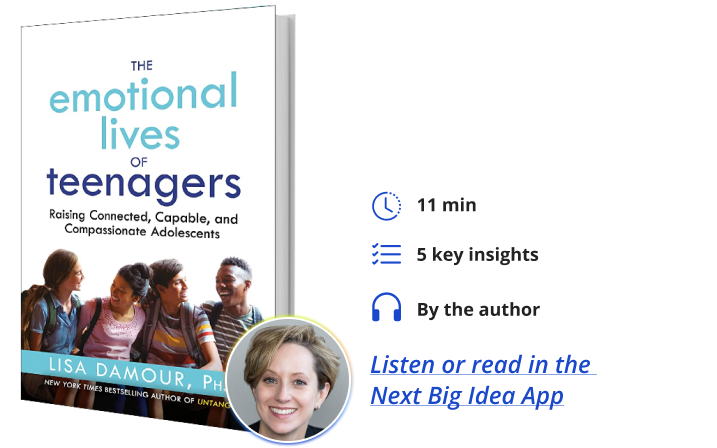Dr. Lisa Damour is a clinical psychologist and psychotherapist that helps adults understand and support their teenagers. She is a regular contributor to CBS News and UNICEF and her work has been published in the New York Times.
Below, Lisa shares 5 key insights from her new book, The Emotional Lives of Teenagers: Raising Connected, Capable and Compassionate Adolescents. Listen to the audio version—read by Lisa herself—in the Next Big Idea App.

1. Mental health isn’t what we think it is.
The cultural definition of mental health has started to veer far away from how we understand mental health as research and clinical experts. We, as a culture, have come to talk about mental health as though it means feeling good: you know you’re mentally healthy, or you know your kid’s mentally healthy, if there is a sense of feeling good or calm or relaxed. While this may sound good, it’s actually not a good definition of mental health. Of course, we all know you could start a day feeling good, calm and relaxed, and then any variety of things could come along that would ruin your day. That doesn’t mean you have a mental health concern, it means you’re having a really bad day.
We want to work with a definition that is accurate, and also vastly more reassuring. Mental health is not about feeling good, but it is about two things: having feelings that fit their context, that make sense in the moment, and managing those feelings effectively.
2. Psychological distress can be evidence of mental health.
Let’s pick up on the guiding definition that mental health is about having feelings that fit the moment and thus managing those feelings effectively. It’s important for us to recognize that sometimes the feeling that fits the moment is a painful feeling. Say, for example, we have a teenage boy who has a big crush on someone, finally lets that person know, and that person makes it clear that they don’t feel the same way. Of course, we expect that he will be upset. He may be very sad, very uncomfortable, or unhappy for a few days. As much as we hate to see him in emotional pain, from the view of psychologists, we would take this as evidence that he works just as he should.
“It’s important for us to recognize that sometimes the feeling that fits the moment is a painful feeling.”
When painful experiences happen, we expect people to feel those emotionally. In fact, if we’re concerned, it should be because of the absence of feelings that make sense in the moment. It can be very hard, especially given all of the distress that teenagers went through in the pandemic, to embrace psychological pain as evidence of mental health. But that really is how it works. When we think about mental health, what we want to focus on is not so much the presence or absence of distress, but whether that feeling is being managed effectively.
To return to our boy, if he were to be kind of weepy or want to go listen to his sad playlist for a while, or try to make himself feel better by going for a run, or maybe take his mind off it a little bit by watching some TV, we would put all of that in the category of handling the feeling well. He is getting relief, and it comes at no cost. If, on the other hand, he was managing the feeling by smoking a lot of marijuana just to make the feeling go away, or maybe hopping online and being really rude about the person who doesn’t like him back, then we might have some grounds for concern. Even though he’s getting relief from what he’s doing, it comes with a price tag.
3. Psychological distress helps teenagers learn and grow.
As much as it can be strange to welcome psychological distress as evidence of mental health, it can seem even more strange to welcome it as a catalyst for growth. But we also know that to be true. There are a couple of ways that we see this play out in the lives of adolescents. Their feelings are informational.
Say you have a kid, and every time she hangs out with a particular classmate, she feels really lousy afterwards. The person isn’t very kind or talks to her in a way that’s diminishing. We would want her to pay attention to that information, and we would want her to use that information to make choices about how much she’s going to hang out with that kid going forward. So, the experience isn’t pleasant, but it has real value.
“They are often experiences out of which kids pivot and become vastly more mature than they were before.”
Another way that we can think about the role of distress in the lives of teenagers is that it does help them grow. Let’s take the same girl and say that maybe she cheats on a test and gets caught by her teachers. This is going to be really unpleasant. She may feel embarrassed or ashamed. She may feel deep regret about having cheated on the test. As the adults who love her, we may hate seeing her go through that painful experience. But one thing I can tell you as a clinician is when I’ve sat with teenagers who’ve gone through hard things, and when they have said to me, “This feels awful, like I don’t want to feel this way again,” those experiences usually give rise to incredible development. They are often experiences out of which kids pivot and become vastly more mature than they were before because they’ve gone through something that they don’t want to have that happen again. They then make better choices going forward.
4. Adults can’t prevent or quickly banish teens’ painful emotions, but we can help teens regulate them.
Distress naturally comes into the lives of teenagers, and often we actually want it to be that way so that they’re learning and growing. As much as we want to help teenagers feel better fast, we can’t always make that happen. We can, however, help teenagers regulate emotions. When we look at emotion regulation, we psychologists divide it into two categories: helping kids (or actually anyone of any age) get relief by expressing their emotions, and helping kids get relief by bringing their emotions back under control.
You may be surprised to hear me put expressing emotions and getting emotions under control on equal footing, but it is how we think about it in psychology. About 20 years ago, I was very pregnant with my older daughter, who’s now a college student. She was my first child and I was wrapping up a meeting with a senior colleague. She knew we wouldn’t see each other until after I’d had my baby. When the meeting was over, she said to me, “Hey, do you want to hear how psychologists mess up their kids?” And I said “YES!” because I knew exactly what she was talking about. She said, “They talk about feelings too much.” As soon as she said it, I knew exactly what she was describing.
“Sometimes parents talk too much about feelings when there are many other options available to help kids feel better.”
One of the hazards of our profession is that when our kids are upset, we might say “Okay, well what’s going on? And how do you feel? And where’s this coming from?” That may have some utility, but there’s also a point—which is what my colleague pointed out—where it becomes helpful to say, “Okay, you’ve been upset about this for a little while, why don’t we try to figure out what will help you feel better?” That way we naturally move towards helping kids bring their emotions back under control. In the intervening 20 years since I had that child, it seems that much of the culture has moved toward being the “bad psychologist” parent, however well-intentioned it may be. This means that sometimes parents talk too much about feelings when there are many other options available to help kids feel better.
5. Getting teens to talk about their feelings when they are upset is only one way to offer support.
As a clinician, I’ve become very aware that we’re at a place in our culture where parents feel like if my teenager is upset, the best, and perhaps only, solution to that moment is to get my teenager to describe what’s wrong, so that an adult can offer my wisdom and support. Sometimes this works great, and when it does, more power to you and to your teenager.
But sometimes we see something else, which is when a teenager starts talking about what’s upsetting and actually becomes even more upset as they go. The term we use for this is rumination. This is when there’s a sense of spinning one’s emotional wheels, or picking at an emotional wound. More time is spent on the problem, but without feeling better about it.
If this is the case, or if a teenager is just not in the mood to talk, the good news is there are a lot of other options. We can give them opportunities for nonverbal expression, and teenagers often find these on their own, such as listening to music, banging on drums, going for a run, “getting their feelings out” in any variety of ways. We can also turn to the long list of things that help kids bring feelings back under control. Sometimes they seek out comfort, sometimes they find a temporary distraction, sometimes they’re very eager to engage in problem solving. Sometimes we as adults can help them get a fresh perspective on whatever the problem is to help them feel better. The bottom line is that sometimes talking works, and if your kid wants to talk, and it is helping them, fantastic. But parents shouldn’t feel like that’s their only option. When it comes to helping teenagers regulate their emotions, we have a lot of choices beyond just talking that work really well for them.
To listen to the audio version read by author Lisa Damour, download the Next Big Idea App today:































